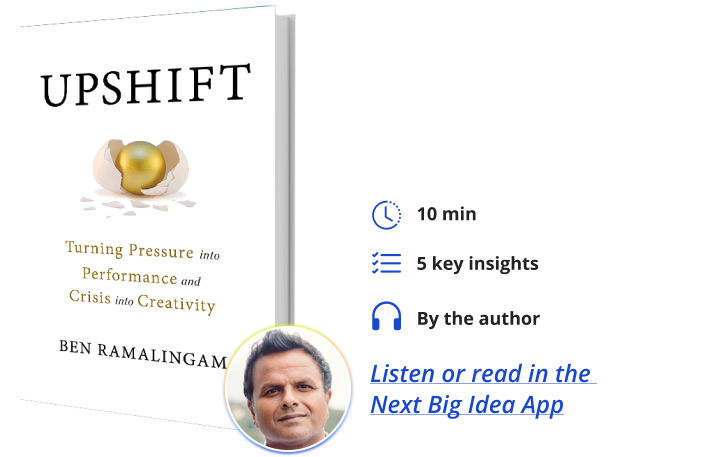Ben Ramalingam works in international disaster response and is the executive director of the United Kingdom Humanitarian Innovation Hub. He is also a senior research associate at the Overseas Development Institute Politics and Governance Program and advisor to the OECD Development Assistance Committee on innovation investments for development, humanitarian and human rights issues.
Below, Ben shares 5 key insights from his new book, Upshift: Turning Pressure into Performance and Crisis into Creativity. Listen to the audio version—read by Ben himself—in the Next Big Idea App.

1. The Inverted-U theory.
A series of famous experiments from the early 20th century first identified an Inverted-U theory that links pressure and performance. In a wide variety of settings, our performance in creative and problem-solving tasks actually increases with stress—up to a threshold point. Beyond this threshold point, with too much stress, we become overloaded and it becomes harder for us to organize our thoughts and gain control of the situation. On the other hand, too little stress isn’t good either. If we’re below the threshold, we quickly become disengaged, demotivated, and unfulfilled.
In this Goldilocks zone, between cognitive overload and underload, where stress level is just right, lies the zone of optimal performance: the zone of “upshifting.” Here we have enough pressure and stress to keep us on our toes, but not so much that it becomes overwhelming.
This zone varies for different people, facing different problems, in different situations. Your optimal point of stress versus performance will be different to someone else. However, we can all learn how to better reach and maintain optimal performance under pressure, how to reach and stay within the zone of “upshifting.” To do this, we need the right mentality.
2. Take on the right mentality.
Extensive research in a wide range of settings has shown that we can use pressure to our advantage when doing something stressful, as long as we have the right mentality. Some research is in the form of simple neuroscientific experiments, where scientists put volunteers into various high stress problems and situations. They were asked to do various activities like singing karaoke in front of strangers and doing math tests under pressure. Participants wore heart monitors, and could see their heart-rate on a monitor during the task.
“Pressure can become a source of positive energy that aids performance.”
These tests showed that the way in which we frame and interpret stress helps us to conjure up new mental context for ourselves and, with that boost, sharpen our performance. When you feel you’re taking on a challenge rather than facing a threat, there’s a series of changes in the chemistry of the brain that focuses your attention and sharpens your performance.
Re-interpreted in this way, pressure can become a source of positive energy that aids performance. It enables students to better manage stress, free divers to reach new records, pilots to land malfunctioning planes, and separates Olympic champions from other elite athletes. The right mentality opens the door to “upshifting”, but to walk through the door we need to harness our originality.
3. Harness your originality.
Let’s look at a puzzle. How many different uses for a paperclip can you think of? Most of your answers will initially be pretty straightforward. For example, use it to clip things together, or repurpose it as a scratching tool or use it to make marks, write with it, like an artist’s tool.
On average, most people will give up after about nine guesses. Some, however, will keep going and will start coming up with more and more original ideas. For example, putting hundreds of paperclips together in a can and using them as a percussion instrument, melting them down to make something new or using them as a coded communication tool. This type of thought experiment is called the Alternative Uses Test and it’s one of the most established means of assessing original thinking. It was actually developed during World War II as a way of getting fighter pilots to think more creatively about their options if they got shot down.
“Our ability to generate creative ideas through exploring many possible solutions hinges on psychological and cognitive factors.”
Among people working in the peak performance zone like fighter pilots, medical responders, firefighters, and surgeons, there is a clear pattern of being able to use divergent thinking under pressure. Our ability to generate creative ideas through exploring many possible solutions hinges on psychological and cognitive factors. This is not a fixed capability, as with our ways of managing stress; we all have different starting points and we can all learn to be more original.
Research shows that by repeating the Alternative Uses Test regularly, we can enhance our creative thinking. In turn, it can lead to long-term improvements in our cognitive capabilities, and even our psychological resilience.
4. Sustaining “upshifts” comes down to our sense of meaning and purpose.
This has a profound impact on whether and how we reach and maintain our optimal performance. Medical research has proven that a greater sense of purpose can help us live longer, happier, and healthier lives, and life purpose has been linked to lower incidences of acute and chronic diseases. In situations where pressure can’t be avoided, you can get people to be creative by instilling a meaningful purpose, a sense that there is an important, urgent need for the work they do.
When the components of purpose are examined in more detail, you can see that purpose is not something that we have or do not have. Purpose is a doing word. It is an emotional and motivational process, something we feel at a visceral level when we engage in activities that we feel are deeply relevant to who we are and what we want and need to do.
5. There is no single best way of performing under pressure.
This has been gleaned from innovators working in different high-pressure contexts, those working in humanitarian response, emergency services, pandemic response, the military, space exploration, surgery, and even the performing arts. There is no single best way of performing under pressure. However, there are six different “upshifter” archetypes, each of which harnesses our distinctive problem solving skills, creativity, and imagination in different ways: constructively challenging the status quo of how things are done; crafting solutions based on a deep understanding of how technical and social aspects fuse together; combining ideas across diverse fields; connecting with the right people at the right time; corroborating approaches by judging what’s good or bad on the basis of whether it works or not; and conducting collective efforts into shared and sustained missions.
“You may not think of yourself as a typical creative type, but we all have a role to play, and we often don’t realize it until we are in the midst of a crisis.”
It’s important to learn about these archetypes and be able to locate yourself among them. You may not think of yourself as a typical creative type, but we all have a role to play, and we often don’t realize it until we are in the midst of a crisis. We can use these archetypes to democratize the very ideas of creativity and innovation and to embrace the diversity and plurality of our cognitive capabilities. In doing so, we should consign the persistent idea of the lone innovator to the dustbin of history.
There is an old adage that suggests that we should never let a good crisis go to waste. The real adage should be that in a crisis, we should never let anyone go to waste. In crisis situations, despite everything we might hear at the moment, diversity is not the problem, diversity is the solution. Embracing this diversity is one way of ensuring that we are more prepared for, and better able to respond to, the crises that will inevitably come in the future.
We need to challenge the assumption that crises kill creativity. For a whole range of problems, in many different settings, people are finding, managing and dealing with pressure and stress in ways that don’t lower their creative abilities, but advance them. In fact, many successful innovators have tapped into this to attain new levels of human and professional excellence. We now live in a world of perpetual simultaneous crisis, what has been termed the global polycrisis. To better manage and cope, we need to see constraints and limitations not as restrictions but as a source of freedom. As Nobel Laureate Ilya Prigogine so eloquently put it, “The future is uncertain, but this uncertainty is at the very heart of human creativity.”
To listen to the audio version read by author Ben Ramalingam, download the Next Big Idea App today:































